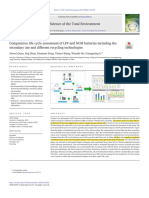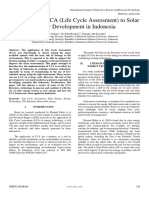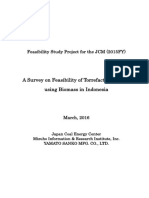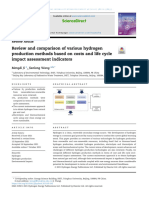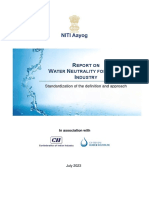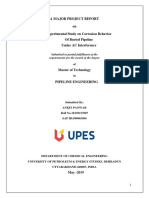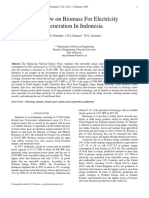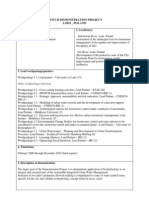LCA Biomas Combustion
LCA Biomas Combustion
Uploaded by
Roxana SoltanCopyright:
Available Formats
LCA Biomas Combustion
LCA Biomas Combustion
Uploaded by
Roxana SoltanCopyright
Available Formats
Share this document
Did you find this document useful?
Is this content inappropriate?
Copyright:
Available Formats
LCA Biomas Combustion
LCA Biomas Combustion
Uploaded by
Roxana SoltanCopyright:
Available Formats
Captulo 7: Anlisis ambiental de la combustin de biomasa.
Captulo 7: Anlisis ambiental de la combustin de biomasa.
Captulo 7: Anlisis ambiental de la combustin de biomasa.
Table of content
1. 2. Introduction to bioenergy ....................................................................................... 3 LCA assessment of biomass energy...................................................................... 5 2.1. 2.2. 2.3. 2.4. 3. 4. 5. 6. Goal and scope definition ............................................................................... 6 Inventory analysis ........................................................................................... 9 Impact assessment....................................................................................... 10 Results ......................................................................................................... 11
Carbon footprint ................................................................................................... 14 Energy Pay Back Time ........................................................................................ 14 Conclusions ......................................................................................................... 14 References .......................................................................................................... 15
Captulo 7: Anlisis ambiental de la combustin de biomasa.
1. Introduction to bioenergy
Bioenergy: The conversion of biomass into useful forms of energy such as heat, electricity and liquid fuels. The modern biomass energy represents the heat, electricity, and/or transport fuels that are produced from biomass-fueled technologies other than those using traditional biomass. Technologies include combustion, gasification, pyrolysis, cogeneration of power and heat, and anaerobic digestion to produce biogas and landfill gas. Liquid biofuel also is a form of modern biomass [Renewables 2011, Global Status Report]. The traditional biomass refers to all the unprocessed solid biomass that it burned to provide heat energy, mostly used in rural areas of developing countries. Biomass is derived from different types of organic matter: energy plants (oilseeds, plants containing sugar) and forestry, agricultural or urban waste including wood and household waste. Biomass can be used for heating, for producing electricity and for transport biofuels. Biomass can be solid (plants, wood, straw and other plants), gaseous (from organic waste, landfill waste) or liquid (derived from crops such as wheat, rapeseed, soy, or from lignocellulose material). [http://ec.europa.eu/energy/renewables/bioenergy/bioenergy_en.htm] A schematic presentation of the different types of biomass fuels and their utilization is presented in Figure 1-1.
Figure 1-1 Types of biomass fuels and their utilization Source: Ecoinvent database, Life Cycle Inventory of Bioenergy
Bioenergy in the world Biomass is widely used in developing countries because it is cheap and easily available. Biomass energy annual usage represents approximately 814% of the world final energy consumption (2010) [A. Williams and co., 2011].
Captulo 7: Anlisis ambiental de la combustin de biomasa.
Biomass supplies an increasing share of electricity and heat and continues to provide the majority of heating produced with renewable sources. An estimated 62 GW of biomass power capacity was in operation by the end of 2010. The United States is the world leader in terms of biomass power generation in 2010, followed by EU countries (Germany, Sweden, United Kingdom), Brazil, Japan, China [Renewables 2011, Global Status Report].
Table 1-1 Bioenergy in the world in 2010
Country
Biomass power capacity [GW] 10,4
Energy generated [TWh] 48
Comments mostly derived from wood, agricultural residues and black liquor burned as fuel for cogeneration in the industrial sector 62,2 TWh from solid biomass. About half of Europes biomass power production came from electric-only facilities and half came from combined heat and power (CHP) plants, but the breakdown varies by country. most generated in CHP plants excluding co-firing with coal combination of sugarcane bagasse, solid biomass, organic waste, and biogas (including from livestock wastes
US
EU states
7,1
87,4 (in 2009)
Germany Brazil Japan China India Thailand
4,9 7,8
28,7 28 10
4 3 1,3
Source: Renewables 2011, Global Status Report
Bioenergy price The power generation from biomass, considering plants between 1-20 MW, has a typical cost of 0,04 0,10 /kWhel [Renewables 2011, Global Status Report]. The electricity generation costs of biomass CHP technologies, based on biomass combustion, is between 0,13 and 0,22 /kWhel [I. Obernberger and G. Thek, 2008], depending on size, fuel price and operating hours. Technologies to use biomass The methods available for the biomass utilization are open fires (up to 3kW th), simple stoves, Patsari cookers and household heating (110 kW th), fixed bed combustors (up to 5 MW th), moving or travelling grate (up to 100 MW th), fluid bed (up to 500 MW th) and pf/suspension firing/and co-firing (up to 900 MW th) [A. Williams and co., 2011]. Direct combustion power plants have a much lower capital investment than solar power, and equipment is widely available. By using high yielding, the cost of electricity is much cheaper than solar electricity. Furthermore, biomass can produce low carbon electricity 24 hours a day which is needed for "base power" applications. [http://www.viaspacegreenenergy.com/direct-combustion.php]
Captulo 7: Anlisis ambiental de la combustin de biomasa.
Depending the technology used, the biomass size is reduced to: 10 m1000 m for PF (pulverized fuel) systems, 2-5 mm or larger for the fluidized bed systems and 5-100 mm (up to 50 cm) for the packed-beds, in order to ensure the complete a high combustion rate [A. Williams and co., 2011]. Combined heat and power (CHP) technologies based on biomass combustion have been developed intensively over the past ten years. For large-scale CHP plants (>2000 kW el) the steam turbine process (Figure 1-2) is economically and technically feasible [I. Obernberger and G. Thek, 2008]. The biomass is stored in the plant, and then passes to the preparation building (depending on the size, is redirected to the proper store) and after that is burned in a boiler. The steam that is produced here is used to produce electricity, through a steam turbine which is connected to an electric generator. Steam-turbine power boilers designed to work primarily with bark can be added to sawmill as an alternative to beehive burners or other apparatus to dispose of waste [Warren and co., 2007]. Direct combustion boiler/steam turbine technology involves the oxidation of biomass with excess air, giving hot flue gases that produce steam in the heat exchange sections of boilers. The average size of the power plants is tens of MW and the electrical energy produced varies in the interval 20 to 25% [A. DOvidio and co., 2008], although some other studies showed an efficiency up to 40% [Warren and co., 2007].
Figure 1-2 Steam turbine system scheme Source: http://www1.eere.energy.gov/tribalenergy/guide/biomass_biopower.html
2. LCA assessment of biomass energy
While biomass possesses the advantage of CO2 neutrality, there are potential problems concerned with the environmental pollution that it causes. All the combustion technologies have a potential of air pollution, releasing: VOC (volatile organic compounds), NOx, SOx, HCl, PAH (polyaromatic hydrocarbons), furans and dioxins etc. These emissions are affecting the air quality as well as human health. In this respect, a life cycle analyses is helpful. Life Cycle Assessment aims at evaluating all environmental impacts associated with a given product or service at all stages of its lifetime from cradle to grave: from resource
Captulo 7: Anlisis ambiental de la combustin de biomasa.
extraction and processing, through construction, manufacturing and retail, distribution and use, repair and maintenance, disposal/decommissioning and reuse/recycling. LCA procedures are usually based on environmental management standards ISO 14040:2006 and 14044:2006 and are carried out in four steps: 1. 2. 3. 4. Goal and scope definition Life Cycle Inventory (LCI) Life Cycle Impact Assessment (LCIA) Interpretation
2.1.
Goal and scope definition
The goal of this study is to gain a solid understanding of the environmental issues associated with the energy generated from the biomass combustion. Additionally, the study has one more goal, and that is to analyse 4 categories of impact, the most representative for this renewable energy. The results of the LCA assessment will be used to compare the bioenergy with other renewable energies, in order to establish which one have the major negative impact over environment. Assumptions and limitation Since no specific case was analysed, the data were extracted from literature (other studies, master thesis etc), journal papers, LCA database, and internet sites. All the data used in this paper were adapted to our functional unit, as no information was found to match. Because no study that will analyse the entire cycle (from the biomass culture to biomass combustion) was found, we collected the data from different studies. In this respect we have collected data regarding the biomass production and biomass transport from one paper [Siyu Chen, 2009], when the data regarding the biomass combustion from a different study [S. Caserini and co., 2010]. Therefore, the LCA comprise the biomass production, the biomass transport and the biomass combustion, even though the process includes also the biomass processing.
Captulo 7: Anlisis ambiental de la combustin de biomasa.
LCA diagram
Plant nursing
Inputs: Diesel Electricity Gasoline Tree seeds Fertilizer
Soil preparation Planting Clearing (of young forest)
Emissions: Dust (PM10) CO2 CO N2O NOx HC SO2 CH4
Thinning of forest area Fertilizing Final felling (harvesting)
Diesel
Biomass transport
Emissions to air: CO2, CO, NOx, HC, SO2, PM, HC, CH4, SO2, N2O;
Energy use Diesel Natural gas
Biomass preparation (eg. into sawmill)
Emissions to air: CO2, CO, NOx, HC, SO2, particles; Emissions to water: N-tot
Air flow Electricity Diesel
Biomass combustion in a CHP plant (100 MW)
Emissions: CO, VOC, NOx, PAH, PM10, SO2,
Electricity Phases analysed in the LCA
Each plantation includes several steps, as stated bellow. The inventory data for each step were extracted from literature [Siyu Chen, 2009; Berg and Lindholm, 2005; Aldentum 2002] and is shown in the Table 2-1. Therefore, for a biomass culture the following steps were needed: Plant nursing: to prepare seedlings. In this process, two machines with 6kW and 50% utilization is used for peat handling and sowing. 1000 plants are kept in 5 plastic cases, which can be used for 4 times. Tractors (60kW and 50% utilization) are used for transporting plants to greenhouse, where diesel oil is used to supply heat. Soil preparation: to prepare the soil for growing trees. It is assumed that 22.5 liters diesel/ha is used to prepare 0.5 ha/h, which equal to 45 l diesel/ha resulting in 1602 MJ/ha (assuming 35.6 MJ/l diesel). Planting: to plant tree seedlings. Trucks, with capacity of 40000 seedlings per truckload, are used to carry the seedlings from the seedling nursery to the 7
Captulo 7: Anlisis ambiental de la combustin de biomasa.
forest. Tractors (30kW) are used in the forest. Fertilizer is assumed to be the same as it is used in the forest with 27.2% nitrogen content. Clearing: to clear some plants in order to limit the competition and protect the best plants, by using a portable clearing saw. Thinning: to conduct by using forest processor in order to raise the productivity of the remaining forest. Fertilizing: to increase the growth rate of the plants. This is done one to three times by using tractors (14%) and helicopters (86%). Fertilizer in this study is considered as N-fertilizer with nitrogen content 27.2% (SKOG-CAN). Final felling: to harvest the woods. Forwarding: to transport the felled wood from felling area to the road side [Siyu Chen, 2009].
The biomass must be transported and prepared into a bioenergy fuel to be burned easily. For the transport was assumed that average distance was 10 km. The biomass will be transported by heavy Lorries, Euro 5. For the biomass combustion was chosen to be analyzed a CHP plant of 100 MW, with an electric efficiency of 17%. The plant uses as fuel wood wastes with a moisture content of 35% study. The plant uses abatement devices typical of waste-to energy plants: bag filters for dust removal, a selective noncatalytic reduction (SNCR) system fed with ammonia in the combustion chamber for NOx control, lime addition to remove acid gases and activated carbon for adsorption of micropollutants such as heavy metals and trace organics [S. Caserini and co., 2010]. All the inputs and outputs are presented in the LCA diagram. As showed in [Siyu Chen, 2009]., the phases of this process that have the highest impact on environment, considering all the phases from the culture to pellet combustion, are the biomass production, biomass transport and the biomass combustion. Therefore, in this paper the phases analyzed will be the three ones mentioned above, as being the less environmental friendly. Functional unit The FU for the entire system was defined as 1.0 MWhel. Impact categories The four categories of impact that would be analyzed: Global warming; Acidification; Eutrophication; Human toxicity
Captulo 7: Anlisis ambiental de la combustin de biomasa.
2.2.
Inventory analysis
Table 2-1 Inventory analysis Biomass culture Use of resources Energy use* Transport Emission factor** 0.43676 Combustion Use of resources
Use of resources Forest land Tree seeds Thinned forest area copper ore iron ore lead ore bauxite uranium ore coal oil natural gas Energy use Electricity diesel gasoline kerosene biofuel Emissions to air CO2 CO2 NOx HC N2O SO2 CH4 Particles
Unit ha kg ha g g g g g kWh kWh kWh kWh MJ MJ MJ
Value 0.00009452 0.00004726 0.00009452 0.0037808 0.00014178 4.2534E-05 2.363E-07 0.002363 9.452E-06 0.00004726 2.363E-06 0 0.004726 6.1438 0.037808 0.042534
Unit MJ/ton***
Value 4.3676
Unit
Value
Emissions to air g g g g g g g g 499.500392 0.085068 0.9452 0.113424 0.033082 2.43389 0.042534 0.18904 CO2 CO NOx PM HC CH4 SO2 N20 g/ton g/ton g/ton g/ton g/ton g/ton g/ton g/ton 32.3 0.0348 0.0852 0.00118 0.0155 0.000371 0.000163 0.000224 274.55 0.2958 0.7242 0.01003 0.13175 0.00315 0.00139 0.0019
Emissions to air PM10 NOx VOC SO2 CO PAH g g g g g mgTEF 2.0016 3.336 0.0008 0.0556 9.452
Emissions to water N-tot Waste Highly active radioactive waste Low active radioactive waste Building waste g g g 0.00009452 0.0491504 0.00014178 g 4.726E-06
*Was assumed a distance of 10 km;
**Emission factors for transportation based on euro engine class (NTM, Bckstrm, 2007).
Captulo 7: Anlisis ambiental de la combustin de biomasa. ***For an energy content of 18 GJ/ton of biomass, are necessary 0,85 tons of biomass to produce 1 MWhe. The emissions therefore calculated for 0,85 tons of biomass. Source: [Siyu Chen, 2009], [NTM, Bckstrm, 2007] and [S. Caserini and co., 2010]
All the emissions were calculated for the FU of 1 MWhe.
2.3.
Impact assessment
The methodology used to quantify the impact for the chosen impact categories is the ReCiPe Midpoint (E) versin 1.05., with the European normalization. Therefore, to fill the tables bellow were used factors of characterization, normalization and weghting. As stated above, the following categories of impact were analysed: Climate change, terrestrial acidifcation, human toxicity and photochemical oxidation.
Table 2-2 Inventory table for the bioenergy from biomass combustion
Impact category Climate change Terrestrial acidification Human Toxicity Photochemical oxidation CO2 CH4 N2O SO2 NOx PAH CO CH4 NOx SO2
*the biomass combustion is considered to be CO2 neutral.
Biomass culture 499.500392 0.042534 0.033082 2.43389 0.9452 0.085068 0.042534 0.9452 2.43389
Biomass transport 274.55 0.0031535 0.001904 0.0013855 0.7242 0.2958 0.0031535 0.7242 0.0013855
Biomass combustion * 2.0016 9.452 0.000834 3.336 9.452 2.0016
Impact characterization is a quantitative step to translate the environmental load into impact. This translation can be realized by introducing equivalency factors, which are determined by the contribution of different substances to the different impact categories according to the physico-chemical mechanisms of the substances.
Table 2-3 Characterized impacts values for bioenergy from biomass combustion
Impact category Climate change Terrestrial acidification Human Toxicity Photochemical oxidation
Unit kg eq CO2 kg eq SO2 Kg eq 1,4-DB Kg NMVOC
Biomass culture 0.50961592 0.00310498 0 0.0011469
Biomass transport 0.27513755 0.00051557 0 0.00073783
Biomass combustion 0 0.008713 1.71E-08 0.009766
TOTAL 0.784753473 0.01233307 1.7097E-08 0.011651181
Many methods allow the impact category indicator results to be compared by a reference (or normal) value. This means, the impact category is divided by the reference. A commonly used reference is the average yearly environmental load in a country or continent, divided by the number of inhabitants. In our case, with the methods used, we compare the results with the European reference.
10
Captulo 7: Anlisis ambiental de la combustin de biomasa. Table 2-4 Normalized impacts values for bioenergy from biomass combustion
Impact category Climate change Terrestrial acidification Human Toxicity Photochemical oxidation
Unit kg CO2
Normalization factor
Biomass culture 5.27E-05 8.08E-05 0.00E+00 2.16E-05
Biomass transport 2.85E-05 1.34E-05 0 1.39E-05
Biomass combustion 0.00E+00 2.27E-04 3.86E-12 1.84E-04
TOTAL 8.12E-05 3.21E-04 3.86E-12 2.19E-04
eq
1.04E-04
2.60E-02 kg eq SO2 Kg eq 1,42.26E-04 DB Kg 1.88E-02 NMVOC
The environmental impacts need to be weighed against one to another to see which one is the most important. Therefore this process is a qualitative and quantitative process, and its meant to measure the severity of the environmental impacts. The reason we use the weighted factors is to express the contribution of each impact category for the global impact of this renewable energy production.
Table 2-5 Weighted impacts values for bioenergy from biomass combustion
Impact category Climate change Terrestrial acidification Human Toxicity Photochemical oxidation
Unit kg CO2
Weighting factor eq 10
Biomass culture 5.27E-04 5.66E-04 0.00E+00 1.30E-04
Biomass transport 2.85E-04 9.39E-05 0.00E+00 8.33E-05
Biomass combustion 0.00E+00 1.59E-03 2.31E-11 1.10E-03
TOTAL 8.12E-04 2.25E-03 2.31E-11 1.32E-03
7 kg eq SO2 Kg eq 1,46 DB Kg 6 NMVOC
2.4.
Results
By following the characterization factors, the environmental load has been translated into specific environmental impacts. The results show that the main activities with the main environmental impact are the biomass culture and the biomass combustion. Although, by the lack of information, and the method used in this paper to quantify the impact, the results may mislead: in the case of human toxicity impact category, the only emission that contribute to the impact analysis was from biomass combustion. Though other studies [Sara Gonzlez-Garca and co., 2011] show a clear and important contribution of biomass culture (harvesting, mechanical weed control, nitrogen fertilization and biomass collection). The production of biomass present a carbon sink, due to the CO2 absorbed from the atmosphere. But even so, are other emissions associated to the culture activities, such as fertilizer application. In case of the climate change impact category, the activities with the higher impact remains the biomass culture and biomass transport, as the biomass combustion is CO2 neutral, CO2 having the highest contribution on this impact category.
11
Captulo 7: Anlisis ambiental de la combustin de biomasa.
For the photochemical oxidation, the main responsible of this result, in the case of biomass production, are the oxidant emissions from diesel combustion (thus all the activities that involve machinery use). Although the biomass combustion remains the most import activity in this case, with high emissions of NOx, SO2 and CO. Again, the biomass culture contributes to the terrestrial acidification impact category, with diffuse emissions from N-fertilizers and NOx emissions from diesel combustion. Even so, the biomass combustion has a higher impact, due to all the emission.
Figure 2-1 Environmental impact of bioenergy for different impact categories
After normalizing the values for each impact category, we can observe that the most impacting activity is the biomass combustion, followed by the biomass culture.
Figure 2-2 Environmental impact profile for bioenergy normalized for each phase of the LCA
12
Captulo 7: Anlisis ambiental de la combustin de biomasa.
The terrestrial acidification, according to the ReCiPe Midpoint (E) versin 1.05. method, is the most significant parameter, followed by the photochemical oxidation, climate change and human toxicity. This is due primarily to the combustion emission of NOx and SO2. This method weights the the terrestrial acidification and photocchemical oxidation mush nore then the climate change or human toxicity.
Figure 2-3 Environmental impact profile for bioenergy normalized for different impact categories
At the end, after weighting all the impacts, it is clear that the terrestrial acidification is the most important impact in the global impact of this technology, followed by the photochemical oxidation.
Figure 2-4 Environmental impact normalized and weighted for bioenergy
There would be some other impact categories that were not analyzed in this study, but that could be important for this bioenergy production, such as: natural land transformation, agricultural land occupation, freshwater eutrophication or fossil depletion.
13
Captulo 7: Anlisis ambiental de la combustin de biomasa.
3. Carbon footprint
The carbon footprint is defined as the total amount of greenhouse gases produced to directly and indirectly support human activities, usually expressed in equivalent tons of carbon dioxide (CO2). Although we considered in this study that biomass combustion is CO2 neutral, as most of the studies presume, it is recognized increasingly that this is incorrect. Indeed, is more carbon positive that fossil fuels, but not neutral. Some references presume that bio-based products are carbon neutral: European Union Emissions Trading Scheme; UK Standard Assessment Procedure for Energy Rating of Dwellings, 2005; PAS 2050 Specification for GHG emissions of goods and services [Eric Johnson, (2009)]. Therefore, in our case the carbon foot-print has this value: 0.78 kg CO2 eq. most of this is given by the biomass culture, though in some others studies [Sara Gonzlez-Garca and co., 2011], this value might be negative (in the case of biomass culture), as it was considered all the CO2 that the culture absorbs during its growth.
4. Energy Pay Back Time
Energy payback is the ratio of total energy produced during a systems normal lifespan, divided by the energy required to build, maintain and fuel it. A high ratio indicates good environmental performance. If a system has a payback ratio between 1 and 1.5, it consumes nearly as much energy as it generates, so it should never be developed Biomass performs well (ratio of 27) when power is produced from forestry wastes. But when trees are planted for the purpose of producing electricity, the ratio is much lower (about 3 to 5), because biomass plantations require high energy inputs. For all biomass options, the distance between the source of biomass and the power plant must be short, otherwise the energy payback ratio drops to very low values [http://www.hydroquebec.com/sustainable-development/]. The payback time for the biomass combustion varies between 0.9 (for a steam production system [B. Prasit and co., 2011]) to 6 years, depending on the applied technology.
5. Conclusions
The bioenergy is more and more used in all the countries along the world, being available and cheap. The most impacting activity in the production of bioenergy is the biomass combustion, although a high impact has also the biomass culture. The LCA analysis showed, after weighting all the impacts, that the terrestrial acidification is the most important impact in the global impact of this technology, followed by the photochemical oxidation. The environmental impact is due to the diffuse emission form biomass culture, diesel combustion from the machinery and transport camions and biomass combustion. 14
Captulo 7: Anlisis ambiental de la combustin de biomasa.
6. References
1. A. DOvidio, M.Pagano, (2009), Probabilistic multicriteria analyses for optimal biomass power plant design, Electric Power System Research; 2. A. Williams, J.M. Jones, L. Ma and M. Pourkashanian, (2011), Pollutants from the combustion of solid biomass fuels, Energy and Resources Research Institute/CFD Centre, University of Leeds, Leeds LS2 9JT, UK; 3. Aldentun, Y. (2002), Life cycle inventory of forest seedling production -- from seed to regeneration site, Journal of Cleaner Production 10(1): 47-55. 4. B. Prasit, P. Maneechot, S. Ladpala, S. Vaivudh, (2011), Optimization and payback period of steam production by biomass combustor for Agro-industry, Energy Procedia, Vol 9; 5. Berg, S. and E.-L. Lindholm (2005). Energy use and environmental impacts of forest operations in Sweden, Journal of Cleaner Production 13(1): 33-42. 6. Bckstrm, S. (2007). NTM-Environmental Data For International Cargo Transport, The Network for Transport and the Environment. 7. Eric Johnson, (2009), Goodbye to carbon neutral: Getting biomass footprints right, Environmental Impact Assessment review 8. Obernberger and G. Thek, (April, 2008), Combustion and gasification of solid biomass for heat and power production in Europe state-of-the-art and relevant future developments; Editor CENERTEC, Portugal; 9. Sara Gonzlez-Garca a,*, Jacopo Bacenetti b, Richard J. Murphy a, Marco Fiala b, (2012), Present and future environmental impact of poplar cultivation in the Po Valley (Italy) under different crop management systems, Journal of Cleaner Production; 10. S. Caserini, S. Livio, M. Giugliano, M. Grosso, L. Rigamonti, LCA of domestic and centralized biomass combustion: The case of Lombardy (Italy), Biomass and Bioenergy 34, pag. 474-482; 11. Siyu Chen, (2009), Life cycle assessment of wood pellet, Chalmers University of Technology, Gteborg, Sweden; 12. Warren E. Mabee, John N. Saddler, (2007), Forests and energy in OECD countries, Editor: Food and agriculture organization of the United Nations (FAO); 13. Ecoinvent database, Life Cycle Inventory of Bioenergy 14. Renewables 2011, Global Status Report. 15. http://www.hydroquebec.com/sustainable-development 16. http://ec.europa.eu/energy/renewables/bioenergy/bioenergy_en.htm 17. http://www.viaspacegreenenergy.com/direct-combustion.php 18. http://www1.eere.energy.gov/tribalenergy/guide/biomass_biopower.html
15
You might also like
- Comparative LCA of LFP and NMC Batteries Including Secondary Use and Different Recycling Technologies (Quan Et Al 2022)Document11 pagesComparative LCA of LFP and NMC Batteries Including Secondary Use and Different Recycling Technologies (Quan Et Al 2022)irdantoNo ratings yet
- Geothermal Development in Republic of Djibouti: A Country Update ReportDocument16 pagesGeothermal Development in Republic of Djibouti: A Country Update ReportdidierNo ratings yet
- Agrest-Berkes Biomass Technologies Proviso Rio en InglesDocument27 pagesAgrest-Berkes Biomass Technologies Proviso Rio en InglesJuan GomezNo ratings yet
- Frosch Et Al. - 1989 - Strategies For ManufacturingDocument10 pagesFrosch Et Al. - 1989 - Strategies For ManufacturingGKNo ratings yet
- The Climate Change Playbook - AvalancheDocument8 pagesThe Climate Change Playbook - AvalancheChelsea Green Publishing100% (1)
- PTT TemplateDocument2 pagesPTT TemplateKaren Feyt MallariNo ratings yet
- Application of LCA (Life Cycle Assessment) To Solar Energy Development in IndonesiaDocument5 pagesApplication of LCA (Life Cycle Assessment) To Solar Energy Development in IndonesiaInternational Journal of Innovative Science and Research Technology100% (1)
- DIN ISO 14042 Environmental Management - Life Cycle Assessment - Life Cycle Impact AssessmentDocument24 pagesDIN ISO 14042 Environmental Management - Life Cycle Assessment - Life Cycle Impact AssessmentGabi CaravanNo ratings yet
- Petra Nova DOE NETL ReportDocument63 pagesPetra Nova DOE NETL ReportSally Jo SorensenNo ratings yet
- Applications of Energy Storage Systems in Wind Based Power SystemDocument8 pagesApplications of Energy Storage Systems in Wind Based Power SystemEditor IJTSRDNo ratings yet
- Co2 EmissionDocument10 pagesCo2 EmissionDarrold LimNo ratings yet
- Plastic Waste To SyngasDocument10 pagesPlastic Waste To Syngaswaseemkhan49No ratings yet
- Coursework I Brief (LCA)Document7 pagesCoursework I Brief (LCA)AhmedNo ratings yet
- A Review of The Mathematical Models For Predicting Rotary Desiccant WheelDocument44 pagesA Review of The Mathematical Models For Predicting Rotary Desiccant WheelAlexander VovaNo ratings yet
- Biomass Torrefaction in Indonesia - March, 2016Document17 pagesBiomass Torrefaction in Indonesia - March, 2016Herman Eenk HidayatNo ratings yet
- Energy Efficiency in Indonesia by ApkenindoDocument19 pagesEnergy Efficiency in Indonesia by ApkenindoJudianto Hasan100% (1)
- Liden 1988Document16 pagesLiden 1988Sajid Mohy Ul DinNo ratings yet
- EnPI V5.0 Algorithm DocumentDocument14 pagesEnPI V5.0 Algorithm DocumentDalila AmmarNo ratings yet
- Paper Tulehu GeothermicsDocument15 pagesPaper Tulehu Geothermicsyuki himeNo ratings yet
- Chernobyl PresentationDocument49 pagesChernobyl PresentationVelavan Arumugam50% (2)
- A Multidisciplinary Approach To A Complex Phenomenon: Managing The Greenhouse 3Document77 pagesA Multidisciplinary Approach To A Complex Phenomenon: Managing The Greenhouse 3Nadia AabidahNo ratings yet
- Industrial Symbiosis KPIsDocument36 pagesIndustrial Symbiosis KPIsMitul PatelNo ratings yet
- Batch5supercapacitor 150808131503 Lva1 App6892Document54 pagesBatch5supercapacitor 150808131503 Lva1 App6892Kalamchety Ravikumar SrinivasaNo ratings yet
- Techno-Economic Analysis of Hydrogen Production by Gasifacation OfBiomassRvision - 1Document154 pagesTechno-Economic Analysis of Hydrogen Production by Gasifacation OfBiomassRvision - 1stanleyameyerhhoh2hydrogenNo ratings yet
- NREL - Process DesignDocument147 pagesNREL - Process Designsum1else4No ratings yet
- ICCT Zero Emission Freight Trucks White PaperDocument59 pagesICCT Zero Emission Freight Trucks White PaperChinh VuNo ratings yet
- Subha TR FinalDocument26 pagesSubha TR Finalsile nceNo ratings yet
- NREL ReportDocument165 pagesNREL Reportjayendra9No ratings yet
- My Proposal 1Document16 pagesMy Proposal 1Rahi FurqanNo ratings yet
- PHD Thesis of Y K MohantyDocument256 pagesPHD Thesis of Y K MohantyAnonymous P7J7V4No ratings yet
- Chemical Engineering Science: K. Papadikis, S. Gu, A.V. BridgwaterDocument10 pagesChemical Engineering Science: K. Papadikis, S. Gu, A.V. Bridgwatershoemakerlevy9No ratings yet
- EPI Tool CementDocument6 pagesEPI Tool CementjoselpalomaNo ratings yet
- The Potential of Integrating Wind Power With Offshore Oil and Gas Platforms-2010Document14 pagesThe Potential of Integrating Wind Power With Offshore Oil and Gas Platforms-2010hugo999100% (1)
- Esco in IndonesiaDocument22 pagesEsco in IndonesiaJudianto HasanNo ratings yet
- Simapro Database Manual: Methods LibraryDocument74 pagesSimapro Database Manual: Methods LibraryAdhe MartiyaNo ratings yet
- Mixed Technology HV Switchgear and SubstationsDocument8 pagesMixed Technology HV Switchgear and Substationswas00266No ratings yet
- CASBEE-UDe 2014manualDocument99 pagesCASBEE-UDe 2014manualImen DencheNo ratings yet
- Review and Comparison of Various Hydrogen Production Methods Based On Costs and Life Cycle Impact Assessment IndicatorsDocument24 pagesReview and Comparison of Various Hydrogen Production Methods Based On Costs and Life Cycle Impact Assessment IndicatorsesoubihNo ratings yet
- Report Mini Project-Group 1Document129 pagesReport Mini Project-Group 1NISA NABILAH MOHD ASRINNo ratings yet
- Recent Advances in Liquid Organic Hydrogen Carriers: An Alcohol-Based Hydrogen EconomyDocument15 pagesRecent Advances in Liquid Organic Hydrogen Carriers: An Alcohol-Based Hydrogen EconomySajid Mohy Ul Din100% (1)
- B. Danon - 2015-DL LimoneneDocument13 pagesB. Danon - 2015-DL LimoneneRubia Binti IdrisNo ratings yet
- Capital Cost Scaling MethodologyDocument45 pagesCapital Cost Scaling MethodologyManish ParetaNo ratings yet
- Energy Card - C-Results Presentation 03Document40 pagesEnergy Card - C-Results Presentation 03Inhinyero SibilNo ratings yet
- TRM401 Energy-Savings-Calculator pump-and-fan-VFD v4 1 14Document30 pagesTRM401 Energy-Savings-Calculator pump-and-fan-VFD v4 1 14anuragpugaliaNo ratings yet
- Techno-Economic Modelling and Cost Functions of CO Capture ProcessesDocument11 pagesTechno-Economic Modelling and Cost Functions of CO Capture ProcessesAlex Mark100% (1)
- Hidrogeno Revision PDFDocument6 pagesHidrogeno Revision PDFtunja1No ratings yet
- Techno-Economic Assessment of A Novel Integrated Multigeneration System To Synthesize E-Methanol and Green Hydrogen in A Carbon-Neutral ContextDocument12 pagesTechno-Economic Assessment of A Novel Integrated Multigeneration System To Synthesize E-Methanol and Green Hydrogen in A Carbon-Neutral Contextghalib raduanNo ratings yet
- Eco Indicator CalculationDocument11 pagesEco Indicator CalculationIonuţIpNo ratings yet
- Concentrated Solar PowerDocument7 pagesConcentrated Solar Powermladbos6065No ratings yet
- Energies: Experimental and Numerical Analyses of A Flat Plate Photovoltaic/Thermal Solar CollectorDocument21 pagesEnergies: Experimental and Numerical Analyses of A Flat Plate Photovoltaic/Thermal Solar CollectorAmmar Bany AtaNo ratings yet
- Report On Water Neutrality Framework WR&LR VerticalDocument52 pagesReport On Water Neutrality Framework WR&LR VerticalDevendra SinghNo ratings yet
- Life Cycle Assessment of Electricity Generation in Mauritius - SIMAPRO PDFDocument11 pagesLife Cycle Assessment of Electricity Generation in Mauritius - SIMAPRO PDFLeonardo Caldas100% (1)
- Final Project ANKITDocument38 pagesFinal Project ANKITankit panwarNo ratings yet
- A Review On Biomass For Electricity Generation in Indonesia: D.S. Primadita, I.N.S. Kumara, W.G. AriastinaDocument9 pagesA Review On Biomass For Electricity Generation in Indonesia: D.S. Primadita, I.N.S. Kumara, W.G. Ariastinad handikaNo ratings yet
- Ocean Energy Prospective in Indonesia at America 2022Document42 pagesOcean Energy Prospective in Indonesia at America 2022amfNo ratings yet
- Methane Guidelines Final November 10 2022Document71 pagesMethane Guidelines Final November 10 2022Justice FCONo ratings yet
- Life Cycle Assessment and EnergyDocument8 pagesLife Cycle Assessment and EnergyIHZA RAMADHANNI FITRA IPBNo ratings yet
- A Comparative Overview of Energy - Jan Van StaverenDocument146 pagesA Comparative Overview of Energy - Jan Van Staverendelenda3No ratings yet
- Chapter 2. Solar Thermal EnergyDocument27 pagesChapter 2. Solar Thermal EnergyzalomxisNo ratings yet
- Report On The Potential Role of Hydrogen in IndiaDocument143 pagesReport On The Potential Role of Hydrogen in IndiaKulvinder SoniNo ratings yet
- 2012 FlaretechreportDocument275 pages2012 Flaretechreportalberto esau reyes cruzNo ratings yet
- WAVIN HDPE BOOKLET - Lowres Proof PDFDocument35 pagesWAVIN HDPE BOOKLET - Lowres Proof PDFTANASEGMIHAINo ratings yet
- 7 Prelim Unite Operations HTTP WWW - Eng.uottawa - Ca Profs Kennedy CHG4302Document12 pages7 Prelim Unite Operations HTTP WWW - Eng.uottawa - Ca Profs Kennedy CHG4302Dr Carlos Estrada VázquezNo ratings yet
- New English Sba 2018Document15 pagesNew English Sba 2018ashawni patterson88% (8)
- Pollution Essay 11Document2 pagesPollution Essay 11INTERNET MONSTER100% (2)
- Clean Energy Technologies in Coal Regions Online 02-2020Document201 pagesClean Energy Technologies in Coal Regions Online 02-2020Παναγιώτης ΑλεβίζοςNo ratings yet
- Utilization of SK FundsDocument2 pagesUtilization of SK FundsProvie BaduaNo ratings yet
- Switch Demonstration Project Lodz, Poland: 1. Name of Demonstration: 2. Location(s)Document9 pagesSwitch Demonstration Project Lodz, Poland: 1. Name of Demonstration: 2. Location(s)Free Rain Garden ManualsNo ratings yet
- Clean Plastic Bottle Filled With WaterDocument8 pagesClean Plastic Bottle Filled With WaterSandeep KumarNo ratings yet
- Five Counties Regional Energy From Waste Letter To Peterborough County CouncilDocument4 pagesFive Counties Regional Energy From Waste Letter To Peterborough County CouncilPeterborough ExaminerNo ratings yet
- IssuesDocument30 pagesIssuesJessy BascoNo ratings yet
- MayrDocument4 pagesMayrAnonymous GGc8FbNo ratings yet
- Design of WTPDocument6 pagesDesign of WTPIbrahem Hamdy Naeem100% (4)
- Essay (Saligao Waste Treatment Project)Document3 pagesEssay (Saligao Waste Treatment Project)Avinash BijuNo ratings yet
- Chapter 3 - Externalities and Public PolicyDocument36 pagesChapter 3 - Externalities and Public Policywatts1100% (5)
- Hospital Wastes Management PlanDocument4 pagesHospital Wastes Management PlanRPh Krishna Chandra Jagrit100% (1)
- What Are The Labeling Requirements?: Global Harmonization System - LabelingDocument2 pagesWhat Are The Labeling Requirements?: Global Harmonization System - LabelingeastNo ratings yet
- P EA SY: Cấu trúc dạng bài Causes - Problem - Effect - SolutionDocument7 pagesP EA SY: Cấu trúc dạng bài Causes - Problem - Effect - Solutionphongvo.160600No ratings yet
- London City Hall: Architectural Analysis Course: Intelligent BuildingDocument17 pagesLondon City Hall: Architectural Analysis Course: Intelligent BuildingGeronimo Ortega Baez100% (1)
- EIA Guidance For Induction Electric Arc Cupola FurnaceDocument216 pagesEIA Guidance For Induction Electric Arc Cupola Furnacearjmandquest100% (2)
- VI Department of Agriculture Makes First Land Purchase For Forest Legacy Program 05.09.12Document2 pagesVI Department of Agriculture Makes First Land Purchase For Forest Legacy Program 05.09.12twood4No ratings yet
- (CRET 6013) Chapter One: Introduction To Wind EnergyDocument56 pages(CRET 6013) Chapter One: Introduction To Wind EnergyHenok gebrehiwotNo ratings yet
- Laudato SiDocument2 pagesLaudato SiYuji KojimaNo ratings yet
- I. Donsol Marine Conservation Park (DMCP)Document3 pagesI. Donsol Marine Conservation Park (DMCP)tinny louNo ratings yet
- Concepts of Sanitation and SanitizerDocument10 pagesConcepts of Sanitation and Sanitizernef blance100% (1)
- Discharge Permit Application FormDocument3 pagesDischarge Permit Application FormRhodora Bactol LegaspiNo ratings yet
- Policy On Marine Plastic Waste in Asean and Viet Nam: Environmental Claims JournalDocument14 pagesPolicy On Marine Plastic Waste in Asean and Viet Nam: Environmental Claims JournalDang AnNo ratings yet
- SDB-Totalit Super 80-GB PDFDocument7 pagesSDB-Totalit Super 80-GB PDFMariella Alanya DiosesNo ratings yet
- De Thi Thu Dai Hoc Tieng Anh 2011 The Nay Moi La de Thi ChuDocument6 pagesDe Thi Thu Dai Hoc Tieng Anh 2011 The Nay Moi La de Thi ChuphamthanhlyngaofifaNo ratings yet
